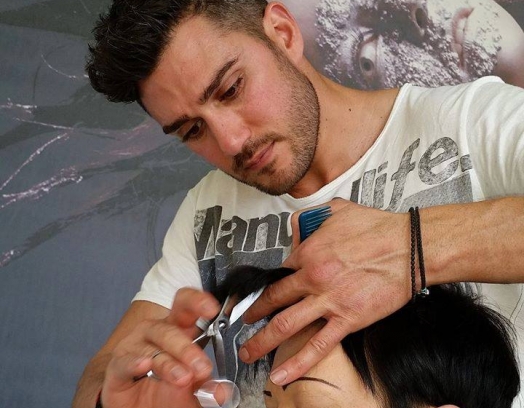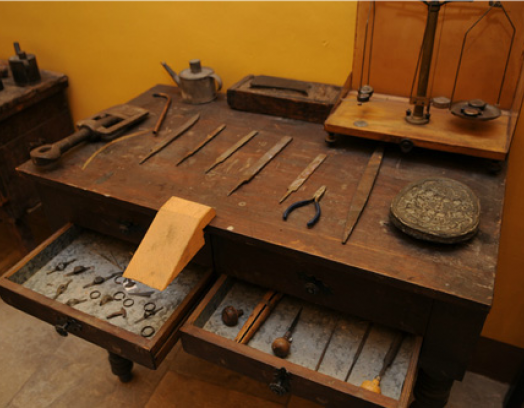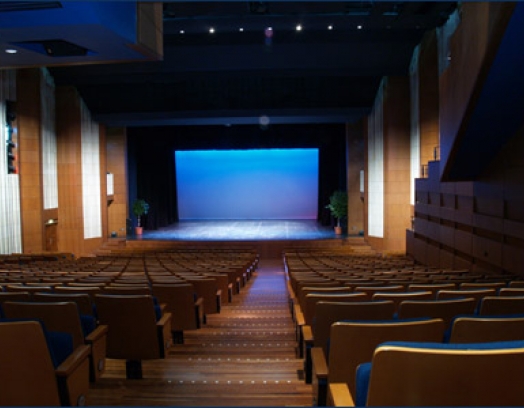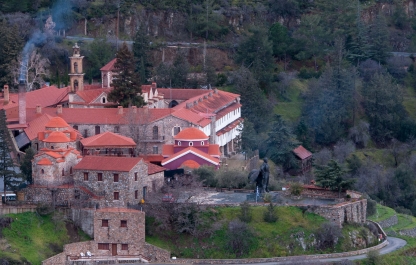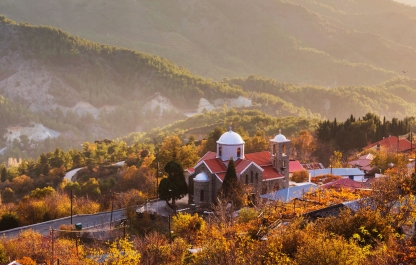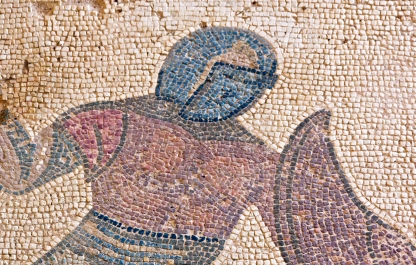Machairas Monastery is one of the most ancient stavropegial monasteries on the island. It was built in the 12th century, in the Troodos woods, close to the village of Lazanias.
You can reach the monastery, which lies at an altitude of about 900 meters, by taking the road that runs through Kapedes village.
Architecturally, the monastery resembles a fortress. It has thick stonewalls, powerful buttresses, ascetic cells and a bridge that runs over a narrow trench.
In the center of the courtyard there is a cross-in-square church with a bell-tower. The present church, which is dedicated to the Virgin Mary of Machera, was built in place of an older church that burnt down in 1892. It houses a miracle-working icon, which as a legends claims, was painted by Luke the Apostle himself. Allegedly, an unknown hermit brought the icon to Cyprus from Constantinople and hid it inside a cave until his death.
There are a couple of theories around the origins of the icon’s name as well as the name of the monastery. Some have alleged a connection with a noble family who owned the land on which the monastery now stands. Others have claimed that the name is related to a rare plant called mahera, whose leaves become razor-sharp during the period of growth (“mahera” means “knife” in Greek). The most popular theory claims that two hermits named Neophytos and Ignatios came to Troodos at the beginning of the 12th century. Guided by a divine prophesy, they encountered an unremarkable cave and macheted their way into it using a sharp knife. Inside the cave the hermits found a sacred relic, which they decided to bring back to Constantinople in order to seek financial help from Emperor Manuel Komnenos for the construction of a church dedicated to the Virgin Mary. The emperor provided the necessary funds and Neophytos and Ignatios returned to Cyprus to oversee the construction of a new monastery.
The number of monk cells grew over time as more people came to inhabit the monastery. The new church was dedicated to the Virgin of Machera. Thick fortress walls were built around courtyard. The inhabitants assumed different responsibilities, with some becoming bakers, blacksmiths, shepherds and even treasurers. Everyone had to live by strict communal rules. The main church holidays celebrated at the monastery were the Presentation of Mary and a holiday dedicated to the founders - St. Ignatius and St. Neophytos.
After the monastery was granted stavropegial privileges, it quickly became a center of spiritual hermitage and Christian culture.
In the middle of the 14th century Leontios Machairas, a Cypriot chronicler, recorded an interesting incident pertaining to the monastery. One day Queen Alice, the wife of King Hugo IV, dared to break the rule prohibiting women from entering the altar space of the monastery’s main church. She paid for her disobedience with her ability to speak. For three years the queen prayed for forgiveness and was finally miraculously cured.
It is also rumored that King Jacob I together with his wife and court sought refuge from a plague within the walls of the Machairas Monastery.
But in 1530 a large fire completely destroyed the monastery, save for the icon of the Virgin of Machera – a priceless relic. The only record of the fire remains on a small fragment of a clay pot, which is currently displayed at the monastery’s museum.
After the fire the monastery became abandoned. Then in the 18th century a Russian monk and traveler Vasily Grigorovich-Barsky visited the island and mentioned in his travel diaries that the monastery was going through a revival thanks to the efforts of Abbot Parfeny.
Active work was underway at the monastery, with church books being rewritten and rebound. In addition to that, a Greek school and a clinic, which provided free medical assistance, were opened at the monastery.
And then in 1892 another fire struck the monastery, destroying all of its buildings. The monks did, however, manage to protect most of the church plate and icons. Reconstruction work lasted for several decades and was completed in 1960.
The present church is a domed three-nave basilica that features columns crowned with figures of angels. The arches, the narthex and the walls of the church are decorated with frescoes painted by a Cypriot artist named Harlabus. The carved iconostasis made of walnut wood by a master named Teogios Kikos is decorated with Venetian-style arches and a tondo.
A relatively recent addition is the two-story building crowned with a gable tile roof. The upper floor houses a spacious church dedicated to St. Gregory Palamas. Gregory was born at the end of the 13th century in a wealthy family. His father was an advisor to a Byzantine emperor. When Gregory was still a boy, he decided to dedicate his life to God. His family supported him in this decision. The young man gave up all of his possessions to the poor and became a novice at the Holy and Great Monastery of Vatopedi on Mount Athos.
During the Renaissance period, which was characterized by a reevaluation of pre-Christian mythology, Gregory Palamas and another monk from Mount Athos spoke in support of the Orthodox teachings on the Divine Light. In 1351 the Council of Blachernae solemnly upheld the orthodoxy of Palamas' teachings.
The façade of the church is decorated with a mosaic that depicts the discovery of the miracle-working icon of the Virgin of Machera and the meeting between the founders of the monastery and the emperor. The paintings on the interior walls of the church tell the story of Gregory Palamas. The side aisles of the church house the chapels of the True Cross and the Virgin Hodegetria.
There is a museum that houses a large collection of religious art, decrees confirming the monastery’s stavropegial status, lamps, incense-burners, church plate, religious manuscripts and books, crosses, rizas and many other objects. In addition to that, the museum also showcases a rare 16th century image of St. Joachim and St. Anna.
Another museum at the monastery is dedicated to Grigoris Afxentiou, who died fighting for Cyprus’ freedom and independence.
Machairas monks also take care of the 15th century cross-domed Byzantine church dedicated to St. Onuphrius, which once belonged to a monastery of the same name. Onuphrius was the son of the king of Persia, who lived in the 4th century. For a long time the king and his wife couldn’t have children and the former prayed that God would send him a son. One day the devil came to visit the king and told him that his wife would indeed bear a child, but he would be from a different father. To test the child’s legitimacy the devil suggested that the king throw him into a fire. If the child survived, it would prove his legitimacy, the devil explained. The king believed the devil and when his wife finally bore a child, the king threw him into a fire. Miraculously, the boy survived the trial. Following the incident, his father was visited by an angel, who asked that the child be named Onuphrius and sent to a monastery.
Onuphrius spent 60 years living alone in a cabin in the woods. But an angel never left his side, bringing him bread and water until his death. St. Pafnuty, who came to visit Onuphrius the day before the hermit’s death, later told his fellow monks that everyone who honored the hermit’s memory would be blessed.
Recently the monastery has seen the construction of new chapels and churches, with more and more religious pilgrims are coming here to see the ancient retreat.



